PipingProjects.eu is one of the leading Pipe Clamp Manufacturer in Europe. Our Pipe Clamp undergo stringent quality control procedures to guarantee compliance and demonstrate exceptional low-temperature impact resistance. Acknowledged as a trusted Pipe Clamp Supplier in Europe, we take pride in delivering products that consistently surpass the most rigorous industry standards. Our commitment to excellence ensures that our clientele receives dependable solutions across a wide range of applications.
A Pipe Clamp is a mechanical device used to secure and support pipes or tubes in a fixed position in a variety of industries. These clamps are used in a variety of scenarios, including plumbing, construction, and industrial environments. Pipe Clamps are typically made up of two parts: the clamp body and a threaded bolt or screw. The clamp body is meant to wrap the pipe or tubing and contains a tightening mechanism. Depending on the design, this can be accomplished with a screw, lever, or other tightening method.
Pipe Clamps are available in a variety of sizes and materials to meet a wide range of pipe diameters and environmental conditions. They are frequently used to secure pipes to walls, ceilings, or other structures, so assuring stability and preventing sagging.

Does this product seem useful to you?
Reach out to us now for quick support.
Trusted
Supplier
Genuine
Product
Easy
purchase
Pipe Clamp Specification Chart
The Pipe Clamp Specification Chart provides essential details for selecting the right clamps, for reliable products in Europe, consult us as a reputable Pipe Clamp Manufacturer in Europe for comprehensive solutions.
| Specification | Description |
|---|---|
| Clamp Type | Split ring clamp, cushioned clamp, u-bolt clamp, etc. |
| Pipe Diameter Range | The range of pipe diameters the clamp can accommodate |
| Clamp Width | Width of the clamp body |
| Clamp Thickness | Thickness of the clamp body |
| Mounting Method | Wall mount, ceiling mount, floor mount, beam mount, etc. |
| Standards | JIS, AISI, ASME, ASTM, AMS, GB, DIN, EN, GOST |
| Grade | |
| Stainless Steel | 200 Series - 201, 202, 205.
300 Series 301, 302, 303, 304, 304L, 308, 309, 309S, 310, 310S, 314, 316, 316L, 316TI, 317, 317L, 321, 347. 400 Series 405, 409, 429, 430, 430F, 430FSe, 434, 436, 442, 446, 403, 410, 414,416, 416Se, 420,420F, 422, 431, 440A, 440B, 440C. 500 Series - 501, 502. 600 Series - 630 (17-4 PH). |
| Carbon Steel | ASTM A106 Gr. A , B & C API 5L Gr. A / B, X42 ,X52 ,X60 ASTM A 53 Gr. A/B |
| Titanium | Titanium 6-4, Gr 1, Gr 2, Gr 3, Gr 4, Gr 5, Gr 7, Gr 9, 5-2.5, 6-2-4-2, 6-4 ELI, 6-6-2. |
| Hastelloy | C22, C276, X, B-2. |
| Monel | 400, K500. |
| Nickel Alloy | Nickel 200 Nickel 201, Alloy 20, Alloy 286, Alloy 218 (Nitronic 60), Nitronic 50 (XM-19). |
| Cupro Nickel | Cu 90-10 (C70600,CW352H), Cu 70-30 (C71500, CW354H). |
| Inconel | 601, 625, 660A, 718, X-750, 825, 925, 608. |
| Duplex / Super Duplex | D S31803, D S32205, SD S32750, SD S32760, SD S32950. |
| Chromium Molybdenum Steel | A387 Gr 2, A387 Gr 12, A387 Gr 11, A387 Gr 22, A387 Gr 22L, A387 Gr 7, A387 Gr 21, A387 Gr 21L, A387 Gr 9, A387 Gr 91. |
| Nichrome Alloy | CrNi 20/80. |
| Copper | ASTM B1, ASTM B2, ASTM B3, ASTM B152, ASTM B124, ASTM B133. |
| Brass | Alloy 260, Alloy 272, Alloy 330, Alloy 353, Alloy 360, Alloy C48200 - C48500, Alloy 464. |
| Bronze | Alloy 954, Alloy 933. |
| Case Hardening Steels | 10C4, 15C8, 15Cr3, 16Mn5Cr4, 20MnCr5, 15Ni5Cr4Mo1, 15Ni5Cr4Mo2, 20Ni7Mo2, 20NiCrMo2, 14CrNi6. |
| En Series | En8, En9, En19, En24, En30B, En31, En36, En45, En47, En48. |
| Mild Steel | Sae 4118, Sae 4120, Sae 4120, Sae 4130, Sae 4135, Sae 4137, Sae 4140, Sae 4142, Sae 4145, Sae 4147, Sae 4150, Sae 4161, Sae 8620. |
What is Hydraulic Polypropylene Tube Clamp?
Pipe Clamp Size Chart
| Pipe Diameter (Inches) | Pipe Clamp Size (Inches) |
|---|---|
| 1/2 | 3/4 |
| 3/4 | 1 |
| 1 | 1 1/4 |
| 1 1/4 | 1 1/2 |
| 1 1/2 | 2 |
| 2 | 2 1/2 |
| 2 1/2 | 3 |
| 3 | 3 1/2 |
| 3 1/2 | 4 |
| 4 | 5 |
| 5 | 6 |
| 6 | 8 |
| 8 | 10 |
| 10 | 12 |
| 12 | 14 |
| 14 | 16 |
| 16 | 18 |
| 18 | 20 |
| 20 | 24 |
Pipe Clamp Dimension Chart PDF
| (mm) Length C | Clamp Size Nominal | (kg) Mass | (mm) RAD. B | (mm) Flange Ø | (mm) Width W |
|---|---|---|---|---|---|
| 69.0 | DN 10/15/20 | 0.17 | 73.0 | 34.0 | 17.0 |
| 60.0 | 1/2″-3/4″ | 0.13 | 63.0 | 25.0 | 17.0 |
| 126.0 | 3″ | 0.42 | 96.0 | 91.0 | 17.0 |
| 85.0 | 1″-1 1/2″ | 0.21 | 78.0 | 50.5 | 17.0 |
| 140.0 | 3 1/2″ | 0.44 | 103.0 | 106.0 | 17.0 |
| 99.0 | 2″ | 0.25 | 82.0 | 64.0 | 17.0 |
| 154.0 | 4″ | 0.51 | 110.0 | 119.0 | 17.0 |
| 165.0 | 4 1/2″ | 0.60 | 115.0 | 130.0 | 17.0 |
| 112.0 | 2 1/2″ | 0.35 | 89.0 | 77.5 | 17.0 |
| 216.0 | 6″ | 0.88 | 134.0 | 167.0 | 25.0 |
What are the Steps to Repair a Pipe Leak Using a Clamp?
What are the Temperature & Pressure limitations for Polypropylene Pipe Clamps?
How to choose the right size of pipe clamp?
PipingProjects.eu is a prominent Pipe Clamp Supplier in Europe, known for its extensive selection of high-quality Pipe Clamp. Among the variety offered at Piping Projects, customers can find Pipe Clamp tailored to their specific needs and industry requirements.
Different Types of Pipe Clamp Available
How to Install a Pipe Clamp?
Installing a pipe clamp is a relatively simple process, but precise processes must be followed to ensure a secure and durable connection. Here's a step-by-step tutorial on installing a pipe clamp:
Pipe Clamp Used in Industries

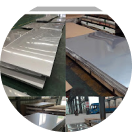
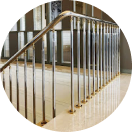
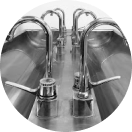
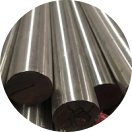
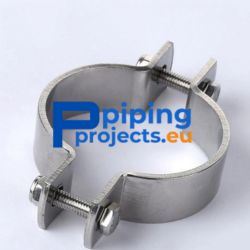
Pipe Clamp Manufacturer in Europe
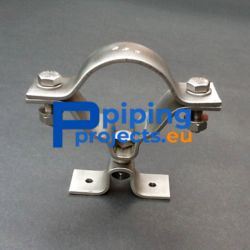
Pipe Clamp Supplier in Europe
